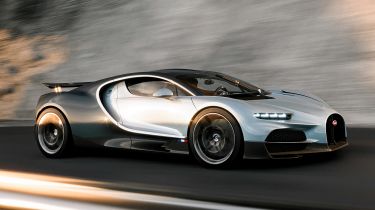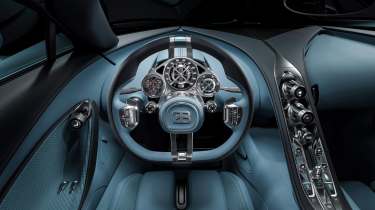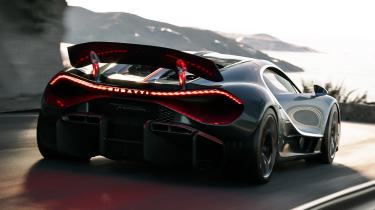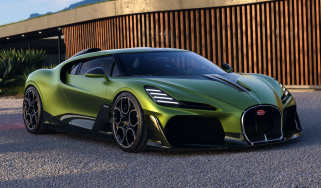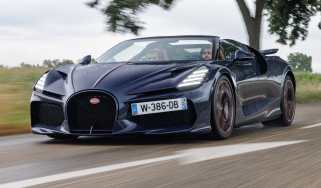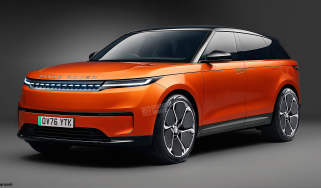1,774bhp Bugatti Tourbillon features an epic-sounding naturally aspirated V16, and hopefully no soft-limiter!
Bugatti’s new awe-inspiringly powerful hypercar features a 987bhp V16, assisted by three electric motors
The all-new, utterly magnificent Bugatti Tourbillon hypercar was unveiled last summer, but petrolheads around the world can now finally bask in the glorious sound of its naturally aspirated V16 engine, thanks to a social media video shared by the pioneering brand’s top boss Mate Rimac.
They feature a prototype of the Tourbillon revving on a test track, with no soft-limiter to hold it back, and then disappearing into the distance in a matter of seconds. Rimac says this is how the production cars will sound, and he’s hoping to keep it “soft-limiter free”.
The footage was captured with the Tourbillon just running on its V16 engine, which alone produces 987bhp and can rev all the way to 9,000rpm. But there are three electric motors and a 25kWh battery pack onboard as well, with the combined power output rated at a dizzying 1,774bhp.
However, the incredibly lucky individuals who get behind the wheel of a Tourbillon will be able to drive in combustion-only, EV-only or hybrid modes because, as Rimac puts it, “we believe in choice” and “you paid for it. You choose”.
Engine and performance
Gone is the quad-turbo W16 engine used by the Bugatti Veyron and Chiron that came before. Their descendent, the Tourbillon, is packing an all-new, naturally aspirated V16 motor that has been developed in collaboration with British engine wizards Cosworth. These are the same masterminds who created the V12 units for the Gordon Murray T.50 and Aston Martin Valkyrie recently.
By the time the Tourbillon starts being manufactured in 2026, it will be the first production car to feature a V16 engine in more than 85 years. With an 8.3-litre capacity, this is a formidable powerplant which can produce 987bhp on its own. That’s the same output as the original Veyron, in fact, but without a single turbocharger in sight.
Instead, three electric motors are connected to this engine that leverage the technical prowess of electric supercar maker Rimac, following its integration with Bugatti into the Volkswagen Group stable. The first motor is sandwiched between the petrol engine and transmission, with the other two powering the purely electrified front axle in a similar fashion to the latest Lamborghini Revuelto. Without a physical connection between the combustion engine and the front axle, Bugatti has been able to use the free space inside the car’s central tunnel to house the 25kWh battery pack which provides up to 37 miles of pure-electric range, and many of its electronics.
The hybrid tech runs on an 800V electrical system and features the latest cutting-edge advancements in electric motor technology, being among the most power dense units available. These three motors produce the remaining 788bhp to create the Tourbillon’s astounding peak power figure.
At this stage there’s not much in the way of verified performance figures, but Bugatti says the Tourbillon will accelerate from 0-62mph in two seconds, 124mph in less than five seconds, 186mph in less than 10 seconds and 248mph in less than 25 seconds.
The Bugatti Tourbillon’s targeted top speed is 275mph – 30mph less than the Bugatti Chiron Supersport 300+, and a likely ramification of the electric motors and their decreasing efficacy as speeds rise to those high levels.
Chassis and suspension
To support this astounding powertrain is a brand-new chassis, utilising the latest advances in material technology. The new composite structure is built in quite a different fashion to the underpinnings of the Veyron and Chiron, with the rear crash structure made of carbon fibre and elements such as the air intakes now integral to the overall structure of the car. The front and rear suspension is still hung on aluminium subframes, but they’re now made of new thin-wall 3D castings and utilise 3D-printing for the complex structural braces.
The same 3D printing technology has also been extensively used in the suspension. New multi-link front and rear suspension layouts replace the previous double wishbones, and all feature ‘organic’ designs that weigh 45 per cent less than the previous forged items in the Chiron. The rear axle also features 3D printed hollow-formed arms, optimised for aero efficiency.
The brakes are carbon-ceramic and are controlled by an optimised brake-by-wire system that blends the regenerative and friction braking systems. The 20 and 21-inch staggered Michelin Pilot Sport Cup 2 rubber is unique, designed specifically for the Tourbillon.
Exterior design
On first sight, you could be forgiven for thinking the Bugatti Tourbillon’s design might not be quite as dramatic a change as the engine, but while the styling themes are similar, the execution is very different. Bugatti’s designers have leaned into its heritage by introducing a distinctive spine that’s inspired by the one found on the 1936 Bugatti Type 57S Atlantic – a necessary addition on that car due to the inability to weld magnesium in that period.
This is further referenced through the Tourbillon’s bonnet, vertically-mounted wiper, roof trim and third brake light. On the side there’s a classic Bugatti C-shape that still defines the car’s profile, but in place of the falling windowline seen on a Chiron is a new upward flick that creates a more compact and aggressive glasshouse.
Interior and technology
Inside the Bugatti Tourbillon, the main themes from the Chiron remain with four vertically-mounted control dials and a relatively clean dash layout. This is contrasted against an ornate steering wheel boss and instrument cluster that, as with a Citroen C4 from the mid-2000s, is separated from the steering wheel itself. Unusually, the spokes are mounted at the 12 and 6-o’clock positions, with controls fixed to the static boss and on the rotating wheel.
The Tourbillon is also the first Bugatti to feature an infotainment screen, but in the attempt to keep the dash itself clean, it’s mounted on an ornate folding mechanism that can also change the display’s orientation to portrait or landscape, depending on the use case.
Price, production and release date
Production of the new Bugatti Tourbillon is due to commence in 2026, with a total of 250 examples being produced. Each will start at 3.8 million euros (£3.16 million), before tax. Variants, derivatives and special editions will follow, of course, but for now consider Bugatti’s new era officially underway.
Click here for our list of the best performance cars
Find a car with the experts
